


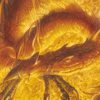
|
|
Title | The Hobbit
| |
Author | J.R.R. Tolkien
| |
Cover Art | John Howe
| |
Publisher | Grafton - 1991
| |
First Printing | George Allen & Unwin - 1937
|
|
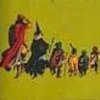
|
|
Title | The Fellowship of the Ring
| |
Author | J.R.R. Tolkien
| |
Cover Art | ---
| |
Publisher | Methuen Publications - 1975
| |
First Printing | 1954
|
|
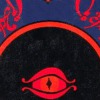
|
|
Title | The Two Towers
| |
Author | J.R.R. Tolkien
| |
Cover Art | ---
| |
Publisher | Unwin Paperbacks - 1977
| |
First Printing | 1954
|
|
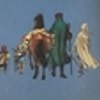
|
|
Title | The Return of the King
| |
Author | J.R.R. Tolkien
| |
Cover Art | ---
| |
Publisher | Methuen Publications - 1975
| |
First Printing | 1955
|
|
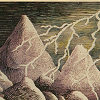
|
|
Title | The Silmarillion
| |
Author | J.R.R. Tolkien
| |
Cover Art | J.R.R. Tolkien
| |
Publisher | Houghton Mifflin - 1977
| |
First Printing | 1977
|
|

|
|
Title | The Book of Lost Tales Vol. 1
| |
Author | J.R.R. & Christopher Tolkien
| |
Cover Art | ---
| |
Publisher | Houghton Mifflin - 1984
| |
First Printing | 1983
|
|
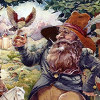
|
|
Title | A Tolkien Miscellany
| |
Author | J.R.R. Tolkien
| |
Cover Art | Gary Lippincott
| |
Publisher | SFBC - 2002
| |
First Printing | 2002
|
|
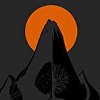
|
|
Title | The Unfinished Tales of Numenor and Middle-Earth
| |
Author | J.R.R. & Christopher Tolkien
| |
Cover Art | J.R.R. Tolkien
| |
Publisher | Harper Collins - 2014
| |
First Printing | 1980
|
|
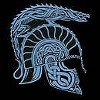
|
|
Title | The Children of Hurin
| |
Author | J.R.R. & Christopher Tolkien
| |
Cover Art | J.R.R. Tolkien
| |
Publisher | Harper Collins - 2007
| |
First Printing | 2007
|
|
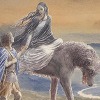
|
|
Title | Beren and Luthien
| |
Author | J.R.R. & Christopher Tolkien
| |
Cover Art | Alan Lee
| |
Publisher | Harper Collins - 2017
| |
First Printing | 2017
|
|
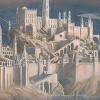
|
|
Title | The Fall of Gondolin
| |
Author | J.R.R. & Christopher Tolkien
| |
Cover Art | Alan Lee
| |
Publisher | Harper Collins - 2018
| |
First Printing | 2018
|
|
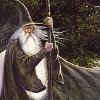
|
|
Title | Meditations on Middle Earth
| |
Editor | Karen Haber
| |
Illustrator | John Howe
| |
Publisher | St. Martin's Press - 2001
| |
First Printing | 2001
|
| |
|
Category | Epic Fantasy
| |
Warnings | None
| |
Main Characters | Gandalf, Sauron, Saruman, Bilbo Baggins, Frodo Baggins, Sam, Meriadoc, Pippin, Legolas, Elrond, Galadriel, Feanor, Gimli, Thurin, Boromir, Aragorn, Gollum, Smaug, Turin, Tuor, Nienor, Glaurung, Beren, Luthien
| |
Main Elements | Wizards, hobbits, elves, dwarves, orcs, dragons
| |
Website | ---
|
|

 The Hobbit The Hobbit
Smaug certainly looked fast asleep, when Bilbo peeped once more from the entrance. He was just about to step out onto the floor when he caught a sudden thin ray of red from under the drooping lid of Smaug's left eye. He was only pretending to sleep! He was watching the tunnel entrance!
Whisked from his comfortable hobbit-hole by Gandalf the wizard and a band of dwarves, Bilbo Baggins finds himself caught up in a plot to raid the treasure hoard of Smaug the Maginificent, a large and very dangerous dragon...
 The Fellowship of the Ring The Fellowship of the Ring
The Lord of the Rings is not a book to be described in a few sentences. It is an heroic romance - "something which has scarcely been attempted on this scale since Spenser's Faerie Queen, so one can't praise the book by comparisons -- there's nothing to compare it with. What can I say then?" Richard Hughes continues, "For width of imagination it almost beggars parallel, and it is nearly as remarkable for its vividness and for the narrative skill which carries the reader on, enthralled, for page after page."
The Fellowship of the Ring delineates the immense power of the One Ring and begins the extraordinary heroic tale of war and adventure which continues in The Two Towers and climaxes in The Return of the King.
 The Two Towers The Two Towers
No summary provided on my copy
 The Return of the King The Return of the King
The Lord of the Rings is not a book to be described in a few sentences. It is an heroic romance - "something which has scarcely been attempted on this scale since Spenser's Faerie Queen, so one can't praise the book by comparisons -- there's nothing to compare it with. What can I say then?" Richard Hughes continues, "For width of imagination it almost beggars parallel, and it is nearly as remarkable for its vividness and for the narrative skill which carries the reader on, enthralled, for page after page."
The Return of the King is the third and final part of the fantastic epic of Middle-Earth.
 The Silmarillion The Silmarillion
The Silmarillion is the core of J.R.R. Tolkien's imaginative writing, a work that he could not publish in his lifetime because it grew with him. Its origins stretch back to a time long before The Hobbit. But The Hobbit was caught up in what Tolkien called "the branching acquisitive theme" begun in the Silmarillion, and eventually The Lord of the Rings emerged from this as well.
Tolkien considered The Silmarillion his most important work, and, though published last and posthumously, this great collection of tales and legends clearly sets the stage for all his other works. For this is the story of the creation of the wold and the happenings of the First Age. This is the ancient drama to which characters in The Lord of Rings look back, and in whose events some of them, such as Elrond and Galadriel took part. The three Silmarils were jewels created by Feanor, most gifted of the Elves. Within them was imprisoned the Light of the Two Trees of Valinor before the Trees themselves were destroyed by Morgoth, the first Dark Lord. Thereafter the unsullied Light of Valinor lived on only in the Silmarils; but they were seized by Morgoth and set in his crown, guarded in the impenetrable fortress of Angband in the north of Middle-Earth. The Silmarillion is the history of the rebellion of Feanor and his kindred against the gods, their exile from Middle-Earth, and their war, hopeless despite all their heroism, against the great Enemy.
The book includes several shorter works, in addition to the Silmarillion itself. Preceding it are "The Ainulindale", a myth of the Creation, and "The Valaquenta", in which the nature and power of the gods is set forth. After the Silmarillion comes the "Alkallabeth", a tale of the downfall of the kingdom of Numenor; and finally, "Of the Rings of Power", the connecting link to The Lord of the Rings.
 The Book of Lost Tales Part I The Book of Lost Tales Part I
The Book of Lost Tales was the first major work of imagination by J.R.R. Tolkien, begun in 1916-17 when he was twenty-five years old and left incomplete several years later. It stands at the beginning of the entire conception of Middle-Earth and Valinor, for the Lost Tales were the first form of the myths and legends that came to be called the Silmarillion. Embedded in English legend and English association, they are set in the narrative frame of a great westward voyage over the Ocean by a mariner named Eriel (or Aelfwine) to Tol Eressea, the Lonely Isle, where Elves dwelt; from them he learned their true history, the Lost Tales of Elfinesse. The in the Tales are found the earliest accounts and original ideas of Gods and Elves, Dwarves, Balrogs and Orcs; of the Silmarils and the Two Trees of Valinor; of Nargothrond and Gondolin; of the geography and cosmography of
the invented world.
The Book of Lost Tales will be published in two volumes; this first part contains the Tales of Valinor, and the second will include Beren and Luthien, Turin and the Dragon, and the only full narratives of the Necklace of the Dwarves and the Fall of Gondolin. Each tale is followed by a commentary in the form of a short essay, together with the texts of associated poems; and each volume contains extensive information on names and vocabulary in the earliest Elvish languages. Further books in this series are planned to extend the history of Middle-Earth as it was refined and enlarged in later years, and will include the Long Lays of Beleriand, the Ambarkanta or Shape of the World, the Lhammas or Account of Tongues, annals, maps, and many other unpublished writings of J.R.R. Tolkien.
 A Tolkien Miscellany A Tolkien Miscellany
For the first time anywhere, this volume gathers together some of Tolkien's least-known and hardest-to-find works in one wonderful volume. Inside you'll find:
Smith of Wootton Major, which tells the story of a magical gift concealed in a most amazing cake, and of the young boy who ate it and learned to travel in the lands of faerie.
Farmer Giles of Ham: A dragon was terrorizing the English village of Ham, and their only hope was a local farmer with an inflated reputation for chasing away giants. Can Farmer Giles and his dog save the village from the dragon and the greedy king?
Tree and Leaf contains Tolkien's ground-breaking essay "On Fairy-stories", still one of the best and most readable examinations of the meaning of fantasy, along with the semi-autobiographical story "Leaf by Niggle," about a painter who never managed to finish his masterwork...when he was alive.
The Adventures of Tom Bombadil: 16 poems from the Red Book - some supposedly written by Sam Gamgee and Bilbo Baggins! - about the Shire, fantastic and humorous events, and the merry life of Bombadil.
Sir Gawain and the Green Knight: We know Tolkien best as a fantasy writer, but his first career was as a professor of Anglo-Saxon. Here are collected his three great translations ofmedieval poetry - "Sir Gawain and the Green Knight", "Sir Orfeo" and "The Pearl."
 The Unfinished Tales of Numenor & Middle-Earth The Unfinished Tales of Numenor & Middle-Earth
Individual tales that expand The Hobbit, The Lord of the Rings and the Silmarillion. Unfinished Tales is a collection of stories ranging in time from the Elder Days of Middle-Earth to the end of the War of the Ring. Its many treasures include:
- The Quest of Erebor, Gandalf's lively account of how he came to send the Dwarves to Bag-End.
- Gollum's capture by Aragorn and Sauron's hunt for the Ring
- The legend of Isildur's death and the alliance of Gondar and Rohan.
- The emergence of the sea-god Ulmo before the eyes of Tuor
- The history of Galadriel and Celeborn and the legend of Amroth
- All that is known of the Druedain, the Five Wizards and the Palantiri.
The collection is edited by Christopher Tolkien, whose commentary places each of the Tales in the context of his father's work.
 The Children of Hurin The Children of Hurin
War has been declared on the Elves by Morgoth, the first Dark Lord, who dwells in his vast norther fortress of Angband. His elemental hatred of the defiant Hurin and his offspring, Turin and his sister Nienor, compels Morgoth to send the formidable wingless dragon of fire, Glaurung, to fulfil his curse and finally destory the last of the children of Hurin.
 Beren and Luthien Beren and Luthien
The "Great Tale" of Beren and Luthien, set during the legendary first age of Middle-Earth.
Beren is a mortal man, but Luthien an immortal Elf, and essential to this tale is the fate that shadows their love. Her father, a great Elvish lord, is deeply opposed to Beren, and imposes on him an impossible task that he must perform before he might wed Luthien.
Undanted by Lord Thingol's challenge, Beren and Luthien embark on the surpremely heroic attempt to rob Morgoth, the greatest of all evil beings, of a Simaril, one of the hallowed jewels that adorn the Black Enemy's crown.
 The Fall of Gondolin The Fall of Gondolin
Gondolin, beautiful but undiscoverable, is central to the enmity of two of the greatest powers in the world.
Morgoth of the uttermost evil seeks in vain to discover the marvellously hidden city of his Elven enemies, while the gods in Valinor refust to support Ulmo, the Lord of Waters, and his designs to protect it.
Into this world comes Tuor, cousing of Turin, and guided unseen by Ulmo he sets out on the fearful journey to Gondolin to warn them of their coming doom. Then Morgoth learns through an act of supreme treachery all that he needs to mount a devastating attack on the city, with Balrogs and dragons and numberless Orcs.

The Hobbit:
Well I couldn't go out and watch the upcoming Hobbit movie without rereading the book now could I? This is one of the books that is sort of hard to review because it is one of fantasy's great classics. If you consider yourself a fan of fantasy you have to at least read this book once.
It makes for a great introduction into Tolkien's world of Middle Earth. This world is simply amazing, the author built it from the ground up, creating it, defining it's languages, its races, their histories, the lay of the land. There aren't many worlds as well developed as this one, if any.
But the Hobbit is this world seen from a very small perspective, from that of Bilbo Baggins, a Hobbit. He spent most of his life in the Shire, quite comfortable in his hobbit hole, no adventures for him, thank you very much. But his life is turned upside down with a group of 13 dwarves and one wizard take him out of his sheltered life to help them retrieve a stolen treasure from a dragon. What is a poor Hobbit to do?
For the most part, this is a lighthearted adventure tale. Lots of singing (which I never really cared for, though they aren't silly jingles, they are epic histories). You meet trolls and elves, spiders and wargs, goblins and dragons. And of course, we find the One Ring, though no one knows that yet...
For many, the Hobbit is the children's version of Lord of the Rings, but for a fan of Middle Earth, this is a key piece of it's vast history. But a fun one to read just the same!
The Lord of the Rings:
How does one go about reviewing the Lord of the Rings? A core classic of fantasy literature it goes beyond the ability to be reviewed. The sheer depth of the world building is completely unmatched anywhere else. Sure you can read the trilogy on their own, but when you see the vast amounts of material that Christopher Tolkien has published (rightly or wrongly given their incomplete states) you comprehend that the history of Middle-Earth has been mapped out for millenia, from its creation to the fading of the Eldar and the rise of Man. Tolkien lived and breathed his creation and you feel it when you read the books and he draws you into his world, it feels real because of its depth and complexity, its history and cultures, languages and places.
I'd read them first back in grade school, and it was 20 years before I picked them up again. When I was younger, I loved the story. I even had a set of toy horses whom I named after the characters of the books and would have them act out the story. Now I appreciate the novels so much more than just their story but for the entire world (though that is all what Tolkien said he wrote, a story. Not an allegory, its not about the second world war with Sauron as Hitler, its not an environmental critique on the consequences of deforestation, its a story and all he claimed to have put into them, so enjoy it for what it is, don't pick it apart, if anything it was an excuse for him to develop the Elven tongues as he was a linguist at his core).
I you enjoyed the movies you must read the book. Peter Jackson did what he could to bring this to screen and it was an amazing accomplishment. But he had to change things around, cut pieces out, you miss glimpses into the world of Middle Earth (like Tom Bombadil) that Tolkien builds around the core story. It is a world to get lost in, one feels there is as much to know about Middle-Earth as their is to know about our own.
The Silmarillion:
Now, after I finished The Hobbit, I decided I'd give the Silmarillion a try. I'd heard all the companion books were dry an boring, so I never got around to reading it before. Well don't believe everything you're told, though tastes will vary.
The Silmarillion is the mythology of Middle Earth. The legends that the Elves recorded, in the songs they sing, and the tales they tell. From its creation by Illuvatar (sort of an equivalent of a god), to its near destruction by Melkor, we learn of the Valar (sort of the equivalent of angelic beings), the origins of the Elves and of Men. It is written in a grand and Biblical style, which is for all intents and purposes what it is for this world.
While I enjoyed the complex language, I could see a lot of people getting bored, it is a kind of history textbook after all. I think the hardest thing for me was keeping track of who was who (not only did they tend to have more than one name, but often changed them over time), and where was where (again, different languages, different names). But I found it fascinating nonetheless, especially the beginning, and the end, which ties into Lord of the Rings. We find out who, or should I say what, Gandalf, Sauron and Sarumann are. We learn the family trees of Galadriel, Elrond and Aragorn.
At this point I'm tempted to reread The Lord of the Rings again, with this new perspective on the places and characters in this epic saga. But maybe I'll save that for next year.
The Book of Lost Tales Part I:
Another year, another hobbit movie (2013) so thought I'd continue with the Middle-Earth theme. There are a lot of similarities between this one and The Silmarillion, with is not surprising since this one is the precursor, the difference being that most of what is in this book was never intended to be published, and not everything fits into the LotR lore in fact there are some outright conflicts. It also has a different feel to it, what with different terminology (gnome instead of elf) and a more fairy tale feeling rather than a grand epic. With every tale Christopher Tolkien included an analysis of the story, how it fit into the evolution of Middle-Earth (which wasn't even called that yet), how it differed from The Silmarillion, and since it wouldn't be a Tolkien book if we weren't dragged into linguistics, that as well (must admit I skipped the bits talking about word roots and pronounciations and variations). Not exactly a quick read and definitely not light, but if you're really a Tolkien fan I think it's worth a read. At the very least you have to appreciate the labour of love that was Christopher's project in bringing these writing to light, it could have been no easy task. It is questionable whose life was more affected by Middle-Earth, the man who created the world, or the son who was brought up in it.
A Tolkien Miscellany:
Includes 16 poems set in Middle-Earth, some starring Tom Bombadil. See my review HERE.
The Unfinished Tales:
I read this after a second reading of the Silmarillion. At first I was a bit dismayed at the fact that there is a lot of overlap and was afraid I'd be bored reading the same thing over again, but I wasn't really. Christopher Tolkien ensured that he presented new materials, whether a different version of a story, or a more detailed version of it. Where it overlapped with the Silmarillion he just make a reference to the other book rather than reprinting the content, mostly highlighting differences and sometimes contradictions between all the various works. It highlights that Middle-Earth didn't just jump into being, it was built, revised, rewritten, and some mysteries are never quite solved. Like who those two blue wizards were, where they went and what they did there...in fact we never learn much about the East of Middle-Earth except that it seems to provide an endless source of evil men, but I'm sure there are stories there too, had Tolkien time to explore in that direction. Same with south into Harad. But if you were curious about little tidbits like the brief encounter with the Pukel-Men, or how the Riders of Rohan can to be, or the origins of the Dunedain, and of course, what the wizards are, then this is the book for you. I really enjoyed it. I spent a month reading the Hobbit, the trilogy, the Silmarillion and then finally this book. I would have continued with the Children of Hurin but I figured going over that story 3 times in one month might be too much! But Middle-Earth is so vast, so complex, I found that I discovered something new in each reading, learned a little more, remembered a few extra fascinating pieces of information. Stuff you don't need to enjoy The Lord of the Rings, but if you love world building as I do, I highly recommend this book (and I recommend reading the appendix to each section, a great wealth of information is included there, sometimes more than in the section itself)
Meditations on Middle Earth:
A collection of essays from various authors describing how Tolkien inspired them to write their own fantasy worlds. See my review HERE.
The Children of Hurin:
This tale is covered in both The Silmarillion and The Unfinished Tales, but here it is fleshed out into full novel length by Christopher Tolkien. His dedication to remain true to his father's work is clear as he strives to do a little to the original prose. And while Tolkien may not have been reading to publish this tale, as a reader, I'm glad his son took the initiative. Middle-earth is such a huge and vast world covering a great length of time, from the creation of the world till the passing of the Elves and the start of the Age of Man that I was desperate to have *more*. To have those epic gaps of history filled in. And this book fit the bill perfect. What a pleasure to return to the world of Middle-earth, even if one geographically different from the more famous Lord of the Rings (there is a great cataclysm that occurs in between, causing most of the land that the older tales take place in to be flooded by the sea...so have to get used to the what is the east in LotR to be the west here). And this tale is quite the epic one, of mistaken identities, miscommunications, a curse that could not be avoided no matter the convoluted path taken, an evil far more powerful than Sauron could ever hope to become. And of course the dragon Glaurung, far more vile than Smaug could ever aspire to. How I wish this could be turned into a movie, though I suspect it's not possible given the large time span covered, but how amazing would it to see the kingdom of the elves when it was at their peak and then their downfall.
Beren and Luthien:
Christopher Tolkien's goal was to show how this tale evolved over time, from when in the Lost Tales Beren was an elf and became the slave of giant cats, to when Beren was a mortal man, and was held in the dungeons of Thu (i.e. Sauron). The tale was written in prose and in poem. And I enjoyed all of it. And I'm someone who isn't much a fan of poetry but in the hands of Tolkien, it is a pleasure to read, the tale just flows (most of the time, sometimes I had to reset the rythym but then Tolkien never did finish this tale nor polish it for publication). And after having read and re-read these tales over the years in different forms I'm finally starting to keep all the characters and their dozen names each straight! I love returning to this world once a year and when I run out I'll start all over again.
The Fall of Gondolin:
Of all the Elven cities of Middle-Earth, I would want to have lived in Gondolin during it's glory days (being human I wouldn't have to live to see it fall) so I looked forward to reading this third of the great tales of the Elder Days of Middle Earth. Even after reading three versions of the tale in a row, and all of Christopher's commentary, I didn't get bored, in fact if anything I was fascinated by the evolution of the tale, and also how it intersects with the other two major stories. Much as I would love to see movie versions of them, they are far too complex and interleaved with each other to do some properly, and also they span enormous periods of time, I'm not sure this can be reflected properly on screen. Besides, these tales are unfinished for the most part, we can only guess at how Tolkien would have finished them had he the time and motivation to do so (he grew quite frustrated with publishers as time went on, even when dealing with Lord of the Rings and their influence on it, such as breaking it into three books when it was only one). And as I noted in last year's review, I am finally really getting comfortable with the names and places, much as they kept changing over various iterations of Tolkien's notes (for example Tuor was once Turlin). I'll never get tired of reading Tolkien's work, if only for the beautiful language, gorgeous imagery, and it's deep worldbuilding. There is little like it out there today, there are likely far a few authors that wrote more about the history of the world in their private notes than they actually managed to publish. But you can really feel how this was a labour of love and not just about getting the next bestseller. And of course, must not forget Alan Lee's gorgeous artworks.

Review by EmilyamI:
The Hobbit - This book is a classic, and I can honestly say that I feel poorly for those who haven't read it. The book is a staple and a foundation for the fantasy genre, as is the author. Tolkien paints a beautiful, detailed picture of his world in language that places the reader in the story, rather than as an observer. The races and species in the book are amazingly defined and each has their own quirks and characteristics. Tolkien even developed an entire set of languages for his elves! If social or cultural aspects of life interest you, this is a definite read. You will encounter numerous peoples that I personally found fascinating.
Individual character development (especially among the dwarves) can prove to be rather lacking. We learn more about the main character, Bilbo Baggins, the character of the dragon Smog, and the character of Gandolf the wizard enough to make them believable and touchable, but the dwarves are treated more as a single entity which could be due to their strong bond and their culture, which seems to insinuate that all dwarves act fairly similarly, and these dwarves have a Musketeer-like outlook of All for one, and one for all.
The pacing of the book could prove troublesome to some readers. There are amazing, thrilling moments of action and suspense. There is, however, a distinct amount of simply walking. Chances are you will still be completely immersed in the story, but you may not find trudging through the countryside to be particularly exciting. I know numerous people who have put this book down because they couldn't read through all of the walking scenes. I urge you to persevere. It's well worth it to get the full experience of Tolkien's masterpiece.
|











